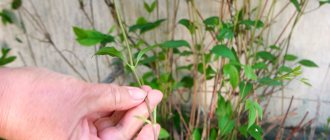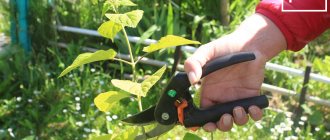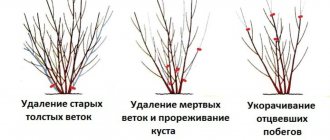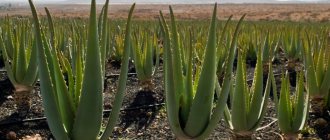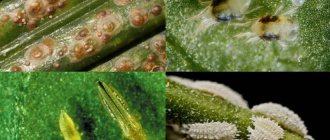Propagate beautiful hydrangeas for free in a couple of weeks in 2 easy steps! Start rooting plants with the secret to trouble-free propagation!
An easy way to multiply your favorite hydrangea varieties: propagate the plant by cuttings! Like many amateur gardeners, you can never have enough hydrangeas as they come in so many different shapes and shades!
Hydrangeas are a perennial favorite in English gardens and farmlands! Hydrangeas make a great gift for friends who love growing flowers!
Each of us can purchase 50 varieties of hydrangea or exchange with gardening friends and propagate hydrangeas by cuttings at home!
All types of hydrangeas, from the spectacular bigleaf hydrangea (Hydrangea macrophylla) to the delightful tree-like hydrangea (Hydrangea arborescens), are easy to propagate. Cuttings propagated last summer begin to bloom next year!
Reproduction methods
If you choose the optimal time and conditions for the propagation of hydrangia, the young bushes will quickly take root. Propagating hydrangeas is not easy. This requires knowledge, patience, attention and time.
The following methods will help with autumn plant propagation:
- cuttings in September;
- dividing a bush with good protection before winter frosts;
- layering in early autumn;
- young shoots (babies).
It is better to grow hydrangea from seeds in the spring. This method requires more care and effort. But even an inexperienced gardener can cope with other methods.
Deadlines
Frost-resistant hydrangea can be propagated on the site both at the beginning of the growing season and at its end. The plant quickly takes root in the soil and tolerates cold well. Despite this, it is necessary to choose the right timing for reproduction.
On average, the culture takes about 3-4 weeks to take root. It is recommended to carry out any work on growing shrubs from the beginning of September to the beginning of October. If you start the propagation procedure too late, the plant may suffer from the first frost.
The large-leaved variety begins to reproduce first, since it does not tolerate cold well.
How to propagate hydrangea from cuttings
If you cut hydrangea in September, you will have to plant it in containers. Further care is carried out at home. But spring or summer cuttings can be rooted directly in open ground.
Important! When cutting cuttings, choose only healthy shoots. Specimens with signs of disease, damage, or pests are not suitable for cuttings.
How to select and prepare cuttings
Half the success will be if you cut the workpieces correctly. It is better to approach this event in the morning or in cloudy weather. For cuttings, use only one-year-old shoots that have not yet become woody. Your assistant in this matter will be a pruning shear or garden shears. Cut the selected shoots obliquely at a distance of 10–15 cm from the top. Remove the lower foliage, leaving only the upper leaves and buds. Cut the remaining sheets in half.
How to propagate hydrangea by cuttings in water
Do not leave harvested hydrangia cuttings without water even for a little while. As soon as you cut them, immediately place them in water or in a pre-prepared solution with a rooting agent. It is better to do this in a transparent glass jar. Root formation stimulators “Kornevin”, “Zircon”, “Heteroauxin” are suitable for this. Dip the cuttings into the solution so much that the upper leaves do not touch the liquid.
Place the workpieces in a bright place, because the formation of roots will depend on this. If you do not have a rooting agent, then use 1 tsp. honey. Change the water in the jar every other day so that it does not become musty. After 3-4 weeks, the cuttings will produce roots up to 2 cm in length.
How to root hydrangea with cuttings in the soil
Propagation by cuttings in the ground is often used. To do this, first place the workpieces in a root formation stimulator for a day. For rooting, use a mixture of peat and sand in a 2:1 ratio or buy a special earthen composition. If you have a lot of cuttings, tie them together in 4 pieces. Deepen the blanks into the prepared substrate to a depth of 5 cm. Spray the seedlings with a spray bottle for a couple of days in a row.
Did you know? The most frost-resistant umbrella hydrangea. It was named so because of the small flowers collected in inflorescences in the form of an umbrella. It also lasts longer than other hydrangeas in water when cut.
Cover the cuttings with glass jars or clear plastic cups . Open them every 5-6 days for ventilation. Remove the caps completely when the cuttings take root. After this, you can plant the seedlings in separate pots and wait until spring, when they will be planted in open ground.
Preparing the soil and planting hole
All hydrangeas prefer acidic soil. The optimal acidity level for them is 5 pH. When preparing the soil for a planting pit, you cannot use components such as dolomite flour, lime, or wood ash. The best soil mixture for hydrangeas would be the following:
- 2 hours of garden soil;
- 2 hours of humus;
- 1 hour high peat;
- 1 tsp coarse sand.
Sheltering hydrangeas for the winter
The optimal size of the planting hole for each division is 50x50x50 cm. Holes should be dug at such a distance that each bush can develop freely in the future.
How to propagate by dividing a bush
The easiest way to propagate in the fall is to divide the bush into several parts. Spring replanting has less impact on the condition of the divisions, while autumn replanting requires careful protection from frost. This must be done before the third ten days of September so that they are sufficiently rooted and strengthened.
Find out more about how to care for hydrangeas in the fall.
How to divide a bush correctly
For division, choose a large shrub. Dig it carefully around a circle with a radius of 50 cm. It is better to use a pitchfork for this, then you will damage the roots of the plant less. Carefully inspect the condition of the bush, pay attention to signs of disease and damage. If you need to divide the root system into more than two parts, then make sure that there are at least 2 renewal buds on each division.
How to plant after dividing a bush
Sprinkle the damaged ends of the roots with charcoal or soak them in green paint. Prepare the holes for transplantation, fertilize them with a mixture of compost, peat and mineral fertilizers. Cover the resulting parts with soil, water, and add peat or sawdust mulch.
When to plant seedlings in a permanent place
Young hydrangeas are planted in the ground next year in the spring. Once the plants begin to show signs of growth, the seedlings begin to be watered regularly. When planting, place 1 tbsp in the hole. a spoonful of complex mineral fertilizer in granules.
Hydrangea is planted together with a lump of earth. To make it easier to remove the plant from the pot, do not water it for the last 2-3 days. After planting the seedling, it is recommended to shorten the shoots by 2/3 of their height - this measure will contribute to the development of a lush bush.
How to properly propagate by layering
In autumn, it is appropriate to make seedlings from cuttings. Carry out a similar procedure after the inflorescences have faded. You can combine this process with covering the hydrangea for the winter. By spring, each sprinkled branch will give rise to a young rooted plant. Do not use woody shoots for this method.
Did you know? If you brought home a bouquet of hydrangia inflorescences from your dacha, you can revive it with citric acid on the tip of a knife. It is enough to add it to a vase with water.
Then follow this plan:
- Carefully loosen the soil around the bush, but do not damage the root system.
- Level the ground.
- Make several grooves (1.5 cm deep), depending on how many branches you need to root.
- Lightly cut the bark on the cuttings in places that will come into contact with the soil in a circle with a knife and treat with a rooting stimulator.
- Press each stem well to the ground where the grooves are located.
- Sprinkle them with soil and place a small stone on top to secure them.
- Make sure that the top of the cuttings is as vertical as possible to the soil. To do this, you can tie it to a peg.
- In dry weather, you can water the places where the branches touch the ground.
- When you do this procedure at the end of September, the cuttings will take root by the end of October. It’s even better to leave them in this position until spring.
If you are new to growing hydrangia, then this breeding method will suit you best.
Caring for seedlings and young bushes
Seedlings should be kept in a warm room with diffused sunlight. Direct rays of the sun can cause burns and the young plant may die. Watering should be regular so that the soil does not dry out. In hot summer weather, it is recommended to spray the leaves with water from a spray bottle.
When mature bushes are planted outside, for better rooting, they are regularly watered and fertilized as needed. An important factor is bush pruning. This helps not only to give it a beautiful shape, but also to rid it of dry stems and inflorescences.
Growing hydrangeas yourself is a complex, multi-step process. But when the first beautiful buds appear, the work is highly justified. And with proper care, the shrub will please the eye for quite a long time.
